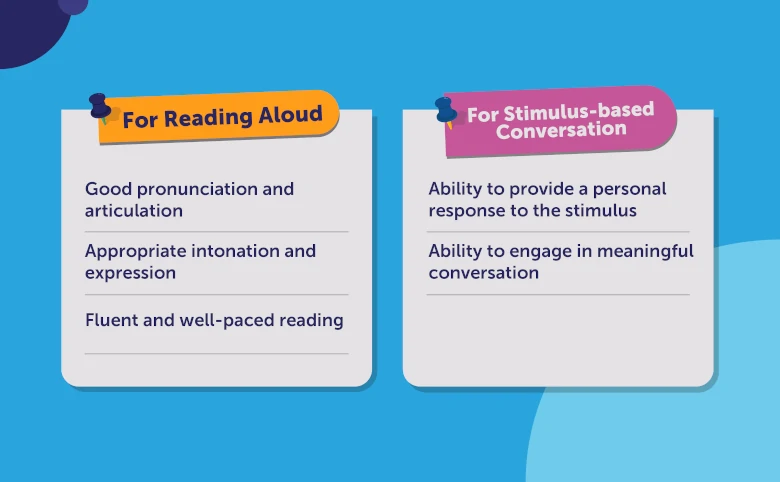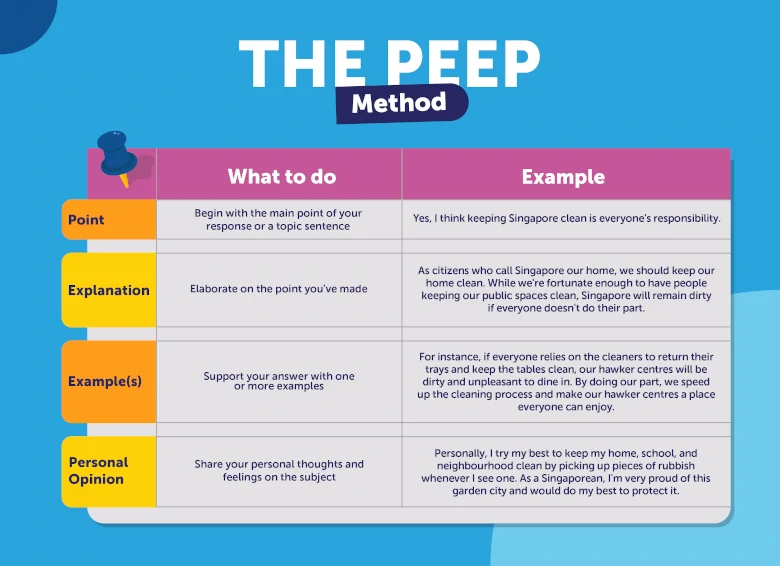PSLE English Oral tips: Impress your examiner with ease (with examples)
- Tags:
- Primary English

Is your child a natural chatterbox?
Or do they slide down their seat whenever the teacher calls their name?
Depending on one's personality, the PSLE English Oral exam can be nerve-racking for some and a walk in the park for others.
That said, even for soft-spoken students, securing a good grade for this paper is not as hard as one might think. The key is in knowing exactly what the examiner is looking for.
In this article, we'll show you everything you need to know about the PSLE English Oral exam so that your child can conquer performance anxiety, impress the examiner, and get nominated for the debate team (fingers crossed).
1. All About PSLE Oral Exam
Taking up 15% of the overall PSLE English grade, scoring well for the oral examination is the surest way to kick your score up a grade or two.
The PSLE Oral English examination is divided into two sections (30 marks):
- Reading aloud (10 marks)
- Stimulus-based conversation (20 marks).
Each student is given 5 minutes of preparation time to familiarise themselves with the passage and stimulus (usually an image) before the exam begins.
2. What Are Examiners Looking For?

- Part 1 - Reading aloud tests your child’s reading ability.
- Part 2 - Stimulus-based conversation assesses your child's ability to respond to the examiner’s questions in a thoughtful and logical manner.
3. Reading Aloud - Part 1
For Reading Aloud, the examiner will assess your child based on Pronunciation, Enunciation, Pacing, Fluency, and Intonation.
-
Good pronunciation and articulation
Even as adults, the anxiety from a job interview or a big presentation can make our voices tremble and leave our tongues in knots. If we can feel that way, what more a 12-year-old in the face of the greatest test of their life?
To prepare them for this, be sure that your child gets ample practice that’ll grant them the confidence they need to get the points they deserve!
Here are a few practical tips:
-
Pronounce the end consonants clearly
eg. ‘s’ at the end of “girls”, “t” at the end of ‘art’, and ‘k’ at the end of “clock”.
-
Watch out for words with tricky endings
eg. gasp (gas-p), glitch (gli-tch), beach (bea-ch)
-
Know the difference between long and short vowels
How do you tell a short vowel from a long one? Here's an easy tip.
Short vowels give off a shorter sound, while long vowels say the name of the alphabet.
For example, “October” and “Open”.
While ‘open’ is a shorter word, the sound of the ‘o’ resembles the name of the letter, therefore it’s a long vowel. On the other hand, despite “October” being a longer word, the sound of the ‘o’ makes a much shorter sound, thus making it a short vowel.
eg. Pig (short) vs Nine (long), Cat (short) vs Cake (long), Rest (short) vs Key (long)
-
Appropriate intonation and expression
Having the right intonation keeps the examiner on the edge of their seat. Without it, you risk putting the examiner in a post-lunch stupor.
Therefore, be sure that you inject feelings into your reading, and put stress on the right words for the desired effect.
For instance, when describing strong emotions like ‘angry”, your child should read it more loudly with a matching expression (eg. slight frowning). By ensuring that your voice goes up and down, you keep the examiner hooked and engaged.
Here's an example.
Jack was starving from having skipped breakfast. Without a second thought, he grabbed his wallet and dashed out the front door.
When you read the italicised words louder, you highlight the importance of Jack’s feelings of hunger, which led to the following actions. When you stress on the right words, you emphasise the key points that bring the passage to life.
Lastly, be sure to use the appropriate tone. If you sound joyful when Susan loses her favourite toy, or sad when Jacob wins first place in a pie-eating contest, you’ll confuse the examiner and put a question mark in their head.
-
Great pacing and well-timed breaks
Now, imagine this.
You’ve been running for hours and not passed a single water station. Your lungs scream for air, and the finish line is nowhere in sight.
Just like running in a poorly-planned marathon, powering through a bunch of long sentences without breaks will leave you breathless. It can’t be done. That said, students who do it tend to mistake reading fast for reading well.
The key to a pleasant reading experience is this: well-paced reading, with pauses in all the right places. Read too quickly, and your child risk tripping over their words. Too slowly, and each word drags its feet across the page and lulls the examiner to sleep.
Most importantly, encourage your child to vary their speed to match the mood of the sentence.
For example, the pace by which your child should read “he ducked under the fence and bolted out of the gate” should be much quicker than “she took a quiet stroll down the empty street.”
4. Stimulus-Based Conversation - Part 2
When it comes to Stimulus-based conversation, the key is to have an easy structure which your child can use to respond to the examiner’s questions in a thoughtful and logical manner.
For starters, encourage your child to structure their answers using the PEEP method: Point, Explanation, Examples, Personal experience/opinion. Not only does this help them organise their thoughts, but it also prevents them from going off-topic.
Here’s how it works.
Example Question:
Does everyone have a part to play in keeping Singapore clean?

Not a Geniebook subscriber yet? Learn more about our three core products - GenieSmart, GenieClass and GenieAsk, and click the banner below to register for a complimentary Strengths Analysis to accelerate your child’s academic journey. All the best for the year ahead!


 SG
SG  VN
VN 




















